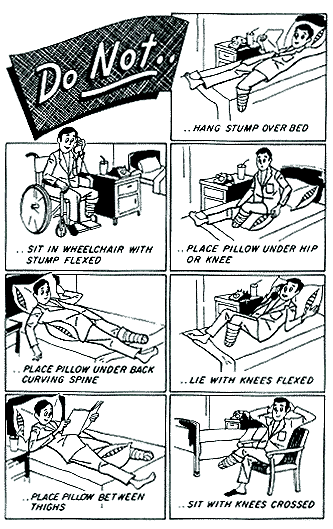 Nearly every amputee feels quite depressed immediately after the surgery, except possibly those who have suffered intense pain for a period just prior to the amputation. This depression is usually replaced early by a will to resume an active life.
Nearly every amputee feels quite depressed immediately after the surgery, except possibly those who have suffered intense pain for a period just prior to the amputation. This depression is usually replaced early by a will to resume an active life.
The dressing applied by the surgeon is either "rigid," usually made of plaster-of-Paris, or "soft," using ordinary cotton bandaging techniques.
When the rigid dressing is used it is left in place for 10 to 14 days during which time most of the healing takes place. Sometimes a simple aluminum tube, or "pylon", and an artificial foot are attached to the rigid dressing so that walking, or gait, training can begin even before the healing period is complete.
When the soft dressing is used, elastic bandages are used soon after surgery to aid circulation. The bandages are removed and reapplied throughout the day. (Instructions for application of elastic bandages are given in the next section.)
Regardless of the type of dressing used, exercises are extremely important to prevent contractures (tightening of the muscles) which, when present, prevent efficient use of a prosthesis.
Some "Don'ts" that will help prevent muscle tightening, or contractures, are shown above.
It is most important that the prescribed exercises be carried out regularly, and the positions shown above be avoided if the greatest benefit is to be obtained from the prosthesis.
The electronic version of this manual is presented by Dankmeyer, Inc., with the permission of the authors. This manual may not be redistributed in any form.